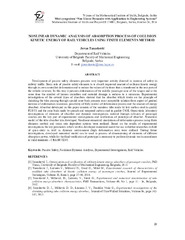Prikaz osnovnih podataka o dokumentu
Non-linear Dynamics Analysis of Absorption Process of Collision Kinetic Energy of Rail Vehicles using Finite Element Method
| dc.creator | Tanasković, Jovan | |
| dc.date.accessioned | 2023-03-13T12:43:47Z | |
| dc.date.available | 2023-03-13T12:43:47Z | |
| dc.date.issued | 2016 | |
| dc.identifier.isbn | 978-86-7746-623-7 | |
| dc.identifier.uri | https://machinery.mas.bg.ac.rs/handle/123456789/5980 | |
| dc.description.abstract | Development of passive safety elements presents very important activity directed in increase of safety in railway traffic. Basic role of passive safety elements is to absorb requested amount of collision kinetic energy through its own controlled deformation and to reduce the values of the force that is transferred to the rest parts of the vehicle structure. In this way it prevents deformation of the middle-passenger zone of the wagon and at the same time the number of human casualties and material damage is reduces to a minimum. Experimental investigations of the several types of absorbers showed that the absorber which works on the principle of shrinking the tube passing through special cone bush presents most acceptable solution from aspect of gradual increase of deformation resistance, possibility of fully control of deformation process and the amount of energy absorbed. Absorber developed in this paper consists of the seamless tube made by low carbon steel in quality P235T1 and the cone bush made by quench and tempered carbon steel in quality C45E. Quasi-static laboratory investigations of elements of absorber and dynamic investigations realized through collision of passenger coaches are the key part of experimental investigations and verification of prototype of absorber. Numerical model of the tube absorber was developed. Nonlinear numerical simulations of deformation process using finite elements method and strain rate dependent options were realized. Based on the results of experimental investigations the key parameters which verifies developed numerical model for use in further researches in field of quasi-static as well as dynamic environment (high deformation rate) were defined. During future investigations, developed numerical model can be used in process of dimensioning of elements of different absorption power, while for the final verification of prototype is necessary to perform dynamic test in accordance to valid standards – CRASH TEST. | sr |
| dc.language.iso | en | sr |
| dc.publisher | Mathematical Institute of the Serbian Academz of Sciences and Arts | sr |
| dc.relation | info:eu-repo/grantAgreement/MESTD/Technological Development (TD or TR)/35045/RS// | sr |
| dc.relation | info:eu-repo/grantAgreement/MESTD/Technological Development (TD or TR)/35006/RS// | sr |
| dc.rights | openAccess | sr |
| dc.source | Mini-symposium “Non-Linear Dynamics with Applications in Engineering Systems”, Booklet of Abstracts | sr |
| dc.subject | Passive Safety | sr |
| dc.subject | Nonlinear Dynamic Analysis | sr |
| dc.subject | Experimental Investigations | sr |
| dc.subject | Rail Vehicles | sr |
| dc.title | Non-linear Dynamics Analysis of Absorption Process of Collision Kinetic Energy of Rail Vehicles using Finite Element Method | sr |
| dc.type | conferenceObject | sr |
| dc.rights.license | ARR | sr |
| dc.rights.holder | Mathematical Institute of the Serbian Academz of Sciences and Arts | sr |
| dc.citation.epage | 30 | |
| dc.citation.rank | M62 | |
| dc.citation.spage | 29 | |
| dc.identifier.fulltext | http://machinery.mas.bg.ac.rs/bitstream/id/14852/bitstream_14852.pdf | |
| dc.identifier.rcub | https://hdl.handle.net/21.15107/rcub_machinery_5980 | |
| dc.type.version | publishedVersion | sr |


